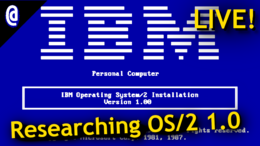Research Stream: Examining Presentation Manager
 | |
| Presentation Manager | |
|---|---|
| VoD Link | N/A |
| Streamed On | N/A |
| Streamed by | NCommander |
| Stream type | Emulated on 86Box |
Description
The goal in this stream is to understand the impact of Presentation Manager on OS/2. Up until Windows 3.1, it was still pretty common to load Exit back into DOS, but there's no way to exit Presentation Manager; it was the intended way to use the system. So what did you get out of the box, how it did evolve, and more?
Rationale
This section describes why certain choices were made for a given stream and more.
Use of Extended Edition
Extended Edition was IBM's special version of OS/2 and was not directly sold to customers. Instead, Extended Edition was available to existing IBM corporate customers, and included additional line of business applications that weren't included out of the box. During the 16-bit era, these applications were
- Database Manager and Query Manager
- Communication Manager
- LAN Server and LAN Requester
While this project mostly deals with OS/2 as a whole, very little software has survived into 2023 for the early 16-bit versions of OS/2. As such, using Extended Edition at least provides additional applications and functionality, so we may get a better idea of how OS/2 was marketed and used, something we'll explore more with Hello World applications and more.
Sidekick
Borland Sidekick was a very popular TSR for handling data, and it was also one of the first available Presentation Manager applications.[1] The direct comparison allows to show how the GUI did or didn't improve things ...
Console Multitasker
This would have probably been the main use for early Presentation Manager, since there were very few native graphical applications at the time period, although I won't be surprised if some developers used TSHELL or the like to make do with less capable hardware.
Questions Asked and Answered
These were questions I wrote down and asked before doing the stream to try and answer them, and my collected feelings over them.
How is Presentation Manager at handling running multiple console sessions at once?
This question was asked originally during the drafting stages. Throughout OS/2's lifespan, there was very little in terms of native applications, nor were many applets included out of the box. Realistically, the most you got was the E Text Editor in OS/2 1.2 and later as a graphical application, and some settings applications.
That mean, by and large, the biggest "value" of Presentation Manager was to be able to do multiple overlapping windows. This in and of itself already has some value. For example, X Windows, both then and now, is commonly used to simply manage multiple terminal emulators. The default configuration for many X environments when running xinit/startx is to load up 2-3 xterms, which in and of itself is a major upgrade over simply working on the console on UNIX/Linux.
Is Presentation Manager an upgrade over the TSHELL interface?
What are the minimum requirements for running Presentation Manager
How does Windows 2.x compare Presentation Manager in OS/2 1.1?
How does the Windows 2.x development environment differ from Presentation Manager?
How does Borland Sidekick compare between DOS and Windows?
Interesting Timestamps
Findings
Gallery
Presentation Manager
Stream Plan
This is likely going to be divided into parts to determine the full context of what's going on
Part 1
- Install OS/2 1.1 Extended Edition
- Try Word as OS/2 console application
- Try out Sidekick for OS/2
- Multitask between Word and Presentation Manager
- Upgrade to OS/2 1.2 Extended Edition
- Look at GUIified EE applications
Part 2
- Install Sidekick for DOS
- Install WordPerfect for DOS
- Install Microsoft C for DOS and OS/2
- Install Windows/286 2.x
- Install Word for Windows/Excel for Windows
- Compare Windows 2.x and PM 1.1
- Compare Windows 3.x and PM 1.2
- Do some Windows app development or the like (like compile example programs)
Stream Notes
E.EXE can only run as a full screen application IBM OS/2 teachs you how to A Tutorial program operates like IBM 3270 with function keys being defined on screen Menu is called Action Bar?! So Presentation Manager is improvement (in usability) over command line, but its very slow Way to running multiple command line applications "nicer" IBM's manuals have printing dates in date Most of chat feels like this is an upgrade IBM OS/2 1.2 - Has dual booting. Microsoft OS/2 1.0 has it. IBM 1.1 (and MSFT 1.1) does nto appear to ... Tom Rune Berg noted OS/2 1.1 had tech demo feels 2 MiB of memory + 640kb was not enough Trying with 4 MiB of memory ... With 4 MiB of memory, pretty laggy/slowly Entry Level systems with Model 30, 50, 60 was between 2-4k, Model 50 with MCA and non EDSI HDD was $4000 IBM OS/2 1.1 Extended Edition - Server components have some minor changes, namely color scheme; first version of LAN Requester, but needs Token Ring or PC Network Card For the PS/2 I need: - EEPROM Programmer - Blank EEPROMs + Eraser - Network Card (16-bit) Disk copying much faster under Windows 286/2.1 Were the Microsoft OS/2 versions notably different in performance? Emulating 10 Mhz 286, 287 and 2560 kb What was the actual sales numbers for various OS/2 versions? 86Box Performacne seems unusually slow - confirm on real hardware Was 286 Segmeneted Protected Mode responsible for slow UI performance of OS/2 Potentially benchmark PM? Look at surviving DDKs OS/2 1.2 Minimium Requirements 3 MiB/30 MiB disk space standard edition Guess we're going to need to look at Microsoft OS/2 versions Locked up on low disk space ... Locked up again ... Install on MS OS/2 1.3 done at 25Mhz for patience reasons ...



